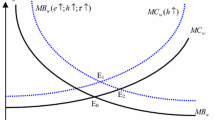Abstract
I estimate a dynamic fixed effects hours equation for prime-age men with bias correction. Studies using household data typically find a weak response in hours of work to changes in the wage. This paper finds that rather than indicating a small elasticity of intertemporal substitution, the weak dependence of hours on wages is the result of delayed adjustment. The coefficient on the lagged dependent variable is found to be between 0.31 and 0.33, which suggests that it takes 1.5 years for an individual in the sample to adjust hours of work to a change in the wage or other preference variables, an important consideration in policy evaluation. Failure to correct for incidental parameter bias leads to underestimating this effect by more than 15%. Time-varying endogeneity of the wage is handled using a control function approach.
Similar content being viewed by others
Notes
See Blundell and MaCurdy (1999) for an overview.
References
Altonji JG (1986) Intertemporal substitution in labor supply: evidence from micro data. J Polit Econ 94(3 Part 2):S176–S215
Altonji J, Paxon CH (1992) Labor supply, hours constraints, and job mobility. J Hum Resour 27(2):256–278
Baltagi BH, Bratberg E, Holmas TH (2005) A panel data study of physicians’ labor supply: the case of Norway. Health Econ 14(10):1035–1045
Beaudry P, DiNardo J (1991) The effect of implicit contracts on the movement of wages over the business cycle: evidence from micro data. J Polit Econ 99(4):665–688
Beaudry P, DiNardo J (1995) Is the behavior of hours worked consistent with implicit contract theory? Q J Econ 110(3):743–768
Biddle JE (1988) Intertemporal substitution and hours restrictions. Rev Econ Stat 70(2):37–351
Blundell R, MaCurdy T (1999) Labor supply: a review of alternative approaches. Handb labor econ 3:1559–1695
Blundell R, Ham J, Meghir C (1987) Unemployment and female labor supply. Econ J 97(388a):44–64
Borjas G (1980) The relationship between wages and weekly hours of work: the role of division bias. J Hum Resour 15(3):409–423
Chetty R (2012) Bounds on elasticities with optimization frictions: a synthesis of micro and macro evidence on labor supply. Econometrica 80(3):969–1018
Chetty R, Friedman JN, Olsen T, Pistaferri L (2011a) Adjustment costs, firm responses, and micro vs. macro labor supply elasticities: evidence from Danish tax records. Q J Econ 126(2):749–804
Chetty R, Guren A, Manoli D, Weber A (2011b) Are micro and macro labor supply elasticities consistent? A review of evidence on the intensive and extensive margins. Am Econ Rev 101(3):471–475
Chetty R, Guren A, Manoli D, Weber A (2013) Does indivisible labor explain the difference between micro and macro elasticities? A meta-analysis of extensive margin elasticities. In: Acemoglu D, Parker J, Woodford M (eds) NBER Macroeconomics Annual 2012, University of Chicago Press, Chicago, pp 1–56
Euwals R, Melenberg B, van Soest A (1998) Testing the predictive value of subjective labor supply data. J Appl Econom 13(5):567–585 Special Issue: Application of Semiparametric Methods for Micro-Data
Fernandez-Val I, Vella F (2011) Bias corrections for two-step fixed effects panel data estimators. J Econom 163(2):144–162
Gonçalves S, Kaffo M (2015) Bootstrap inference for linear dynamic panel data models with individual fixed effects. J Econom 186(2):407–426
Hahn J, Kuersteiner G (2011) Bias reduction for dynamic nonlinear panel models with fixed effects. Econom Theory 27(06):1152–1191
Ham JC (1986) Testing whether unemployment represents intertemporal labor supply behavior. Rev Econ Stud 53(4):559–578 Econometrics Special Issue
Ham JC, Reilly KT (2002) Testing intertemporal substitution, implicit contracts, and hours restriction models of the labor market using micro data. Am Econ Rev 94(2):905–927
Hamilton JD (1994) Time series analysis. Princeton University Press, Princeton
Heckman J, Macurdy T (1980) A life cycle model of female labor supply. Rev Econ Stud 47(1):47–74 Econometrics Issue
Heckman J, Macurdy T (1982) Corrigendum on a life cycle model of female labor supply. Rev Econ Stud 49(1982):659–660
Holtz-Eakin D, Newey W, Rosen HS (1988) Estimating vector autoregressions with panel data. Econometrica 56(6):1371–1395
Kniesner T, Li Q (2002) Nonlinearity in dynamic adjustment: semiparametric estimation of panel labor supply. Empir Econ 27(1):131–148
MaCurdy T (1981) An empirical model of labor supply in a life cycle setting. J Polit Econ 89:1059–1085
MaCurdy T (1983) A simple scheme for estimating an intertemporal model of labor supply and consumption in the presence of taxes and uncertainty. Int Econ Rev 24(2):265–289
Shaw KL (1989) Life-cycle labor supply with human capital accumulation. Int Econ Rev 30(2):431–456
Acknowledgments
I thank Frank Vella for invaluable advice and comments on this paper. I am also grateful to an anonymous referee for very helpful comments.
Author information
Authors and Affiliations
Corresponding author
Rights and permissions
About this article
Cite this article
Schroeder, E. Dynamic labor supply adjustment with bias correction. Empir Econ 51, 1623–1640 (2016). https://doi.org/10.1007/s00181-015-1044-6
Received:
Accepted:
Published:
Issue Date:
DOI: https://doi.org/10.1007/s00181-015-1044-6




